hand
Latest

NBA All-World hands-on: Taking basketball video games back to the streets
This week Niantic is launching a new title called NBA All-World that might be the best application of its location-based tech to date.

MIT’s sensor-packed glove helps AI identify objects by touch
Researchers have spent years trying to teach robots how to grip different objects without crushing or dropping them. They could be one step closer, thanks to this low-cost, sensor-packed glove. In a paper published in Nature, a team of MIT scientists share how they used the glove to help AI recognize objects through touch alone. That information could help robots better manipulate objects, and it may aid in prosthetics design.
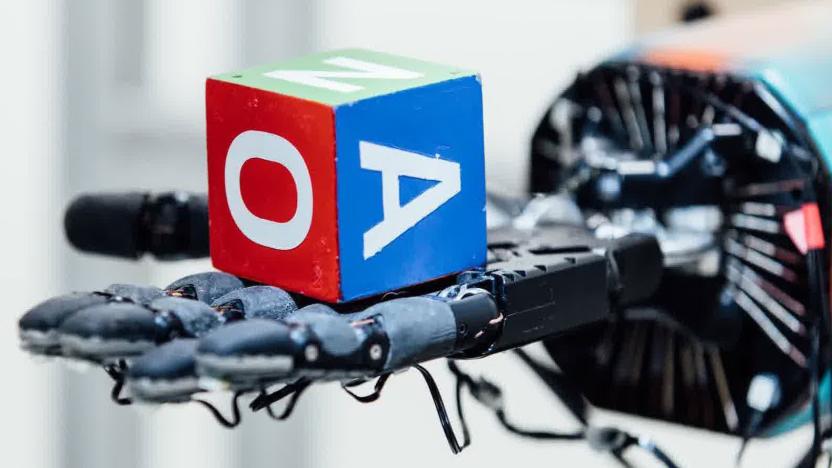
OpenAI's Dactyl system improves the dexterity of robot hands
It's still early days in creating the kind of human-like androids we see in the movies, but new research brings us ever closer to the idea. Boston Dynamics has become the de facto image of locomotion for both humans and their pets, while LG already has its CLOi porter 'bots and DARPA is working on centaur-like designs for disaster relief. Now, researchers at the Elon Musk-founded OpenAI are working on making robot hands more dextrous.

Samsung envisions phones that read your palm
There's a good possibility that you've forgotten a password and had to get hints or recover it. But the process for that isn't very trustworthy. Intruders can guess security questions, for one thing. Samsung might soon have a subtler way of helping you remember your password, though: it would give you a palm reading. A recently published patent application shows that Samsung has been exploring a system that would scan the unique lines on your palm and use them to display hints in the form of incomplete characters. You'd get a nudge in the right direction, but nothing so obvious that a thief could guess it (even if they could use your hand).
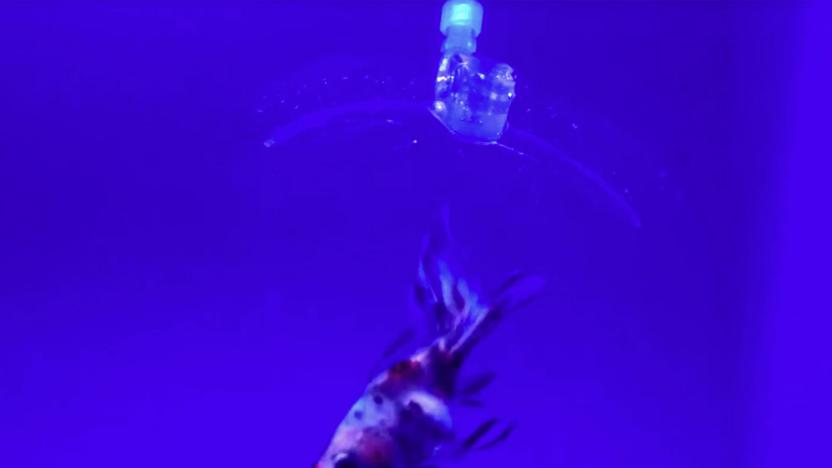
Gel-based robot hand can grab and release fish
Most robot limbs aren't exactly kind to the organic world given all that unforgiving metal, and even rubber-based soft robots aren't very gentle. However, MIT has a better way. It recently built a hydrogel-based soft robot hand that's bio-friendly while remaining tough enough to withstand heavy use. The trick was to use 3D printing and laser cutting to weave hydrogel "recipes" into robotic structures, and pump water into those structures to make them curl or stretch. The results are mostly water-based fingers that still have the strength, durability and speed of more conventional robots.
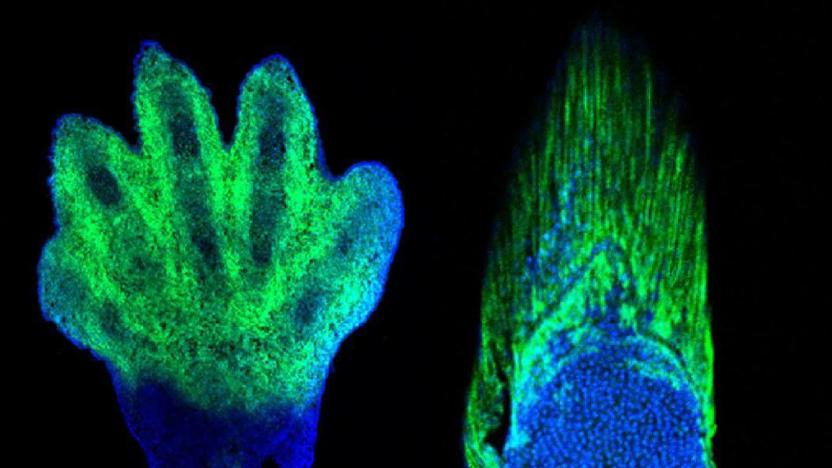
Gene editing helps spot evolutionary link between fins and hands
Gene editing technology isn't just useful for curing the world's ills, it seems. University of Chicago scientists have used the CRISPR technique to discover a key evolutionary connection between fins and hands. Researchers edited fin-related zebrafish genes to make the appropriate cells glow as they develop, and discovered that there's a similar glow in a mouse's digits. In other words, there's a strong similarity in the genes governing fins and digits -- they're both telling embryonic cells to show up at the end of an appendage.
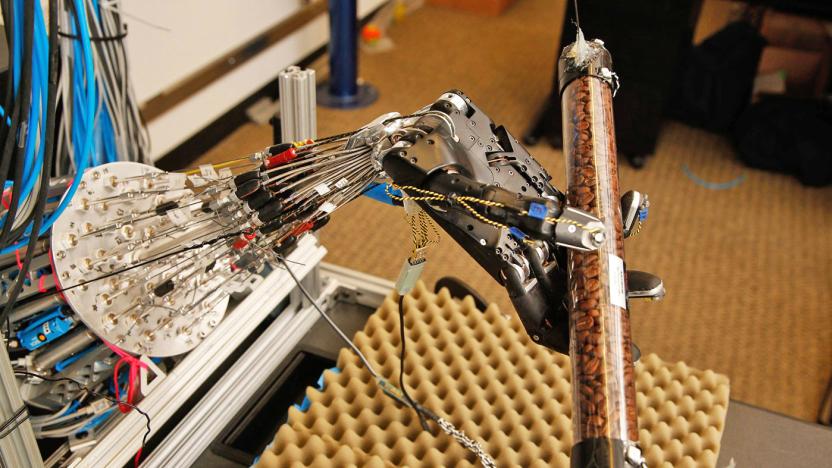
Robot hand learns to twirl objects on its own
Robots can (usually) walk or roll around just fine, but hand control has often proven elusive: it's hard to give them the same kind of finger dexterity as a human. However, University of Washington researchers just got much closer to fulfilling that dream. They've built a robot hand that is not only dextrous enough to spin objects (such as the tube of coffee beans you see above), but learns how to do this on its own. Its algorithm gradually discovers what works and what doesn't -- give it enough time and it'll go from clumsy to reasonably skilled.

Scientists can identify terrorists by their victory signs
To no one's surprise, many terrorists aren't willing to divulge their identities -- they'd rather cover themselves head-to-toe than risk a drone strike or police bust. Researchers, however, may have made it that much harder for these extremists to hide. They've developed a biometric identification technique that can pinpoint people by the V-for-victory hand signs they make. By measuring finger points, the gap between them and two palm points, scientists can identify someone even when there are no other telltale cues. In some cases, it was more than 90 percent accurate.

3D hand scanner could give you custom braces
Many 3D scanners are built to scan whole objects, but that doesn't necessarily cut it if you're trying to scan a specific part. Ever try to map your own hand? Yeah, that doesn't work very well. However, recent graduate Pieter Smakman has a better way. His custom-built Curatio scanner creates a detailed 3D model of your hand simply by putting your hand inside a ring -- you don't have to wave a device around. It uses relatively off-the-shelf parts for the capture process, too, including Raspberry Pi mini-PCs, 32 (!) cameras and laser pointers.

Prosthetic hand restores a man's sense of touch
DARPA promised prosthetic limbs that produce realistic sensations, and it's making good on its word. The agency's researchers have successfully tested an artificial hand that gave a man a "near-natural" level of touch. The patient could tell when scientists were pressing against specific fingers, even when they tried to 'trick' the man by touching two digits at once. The key was to augment the thought-controlled hand with a set of pressure-sensitive torque motors wired directly to the brain -- any time the hand touched something, it sent electrical signals that felt much like flesh-and-bone contact.
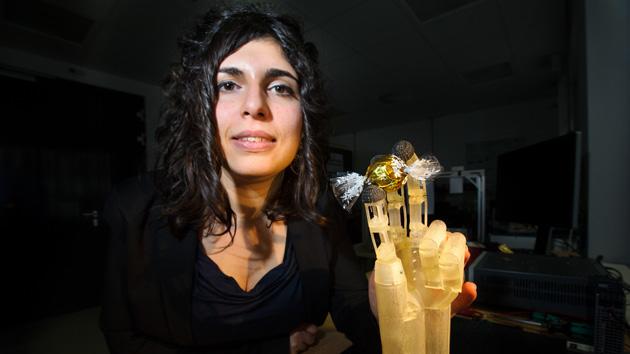
Super-precise artificial hand uses smart wires as muscles
As a rule, bionic hands are clunky contraptions made of motors, pneumatics and other machinery that just can't be as elegant as the real thing. Germany's Saarland University might just change that, however. Its researchers have developed an artificial hand that uses smart nitinol (nickel titanium) wires as its muscles. All you do to make them flex is heat them up or cool them down -- the metal 'remembers' its original shape before you bend it, so you don't need bulky equipment to move it back and forth. The wire bundles are as thin as cotton, but they're very strong and can move with much more precision and speed than usual. They don't even need sensors, since electrical resistance in the wires themselves is enough.

Europe says 'be our guest' to Disney Magical World
It's the circle of life; first a game hits Japan, then North America and then Europe. Heigh-ho, Europe, maybe you should let it go and be happy 3DS game Disney Magical World will be a part of your world on October 24. So, Euro-friends, can you feel the love tonight? Moving on... Disney Magical World, if you're not familiar, combines the light-hearted fun of things like Animal Crossing and Tomodachi Life with a host of Disney-fied mini-games. You can go fishing, do some gardening, manage a cafe, hunt ghosts and - most importantly of all - show off your ballroom moves on the dance floor. The game arrived in North America back in April after proving a hit in Japan, where it shipped 500,000 units. Nintendo also revealed the Pirates of the Caribbean DLC - again already out stateside - is coming to Europe in November, bringing more Captain Jack to the land of Captain Jack.

Disney Magical World trailer is shining, shimmering, splendid
If you think Disney costumes would improve Animal Crossing: New Leaf, or any game for that matter, then Magical World may be for you. The upcoming 3DS game isn't just about playing dress-up, though; it also has mini-games like fishing, planting crops, ballroom dancing, managing a cafe, and a ghost-hunting romp with a touch of the Kingdom Hearts about it. Disney will hope Magical World repeats the success it had in Japan, where it shipped 500,000 units, when it comes to North America on April 11. [Image: Disney]

Willow Garage may sell its Velo robot gripper early, if you ask nicely
Some have called Willow Garage's health into question lately, but the company may have a minor hit on its hands -- if through an unexpected channel. The firm has seen a strong enough response to its Velo robot gripper that it's mulling an early sale of the device this fall, at an educational price somewhere between $500 and $1,000. Whether or not that happens depends on feedback, however. Willow Garage is both offering notification sign-ups and running a feature survey -- if you need a different interface or better performance, now's the time to speak up. There's no guarantee of receiving a Velo when the company might ship just 50 to 100 of the advance units, but you won't get one if you don't ask, will you?

Touch Bionics' latest 'i-limb' offers a powered rotating thumb, smartphone controls
Touch Bionics' i-limb prosthetic hand has advanced quite a bit in recent years, adding features like Bluetooth connectivity and upgraded fingers. Now the company has made available its latest revision, the i-limb ultra revolution, which offers powered thumb rotation for some added dexterity, as well as a new "biosim" app (iOS-only for now) that gives the wearer quick access to 24 different grip patterns in addition to diagnostic and training modes. Of course, the hand isn't only controlled using a phone; as with previous models, it relies on muscle signals to shift into different pre-set patterns, which let the wearer perform a wide variety of actions. You can get a glimpse of some of those capabilities in the video after the break.

Swiss bionic hand offers true sensations through the nervous system
Those wearing bionic hands and similar prostheses often suffer a frustrating disconnect when they can touch an object but can't feel it, even if they're using direct neural control. The École Polytechnique Fédérale de Lausanne and allies in Project TIME have developed a hand that could clear that psychological hurdle. The design implants electrodes directly in key nerves that not only allow motor input, but deliver real sensory feedback from the artificial appendage -- including needle pokes, much to the test subject's chagrin. An early trial (seen above) kept the enhanced hand separate from the wearer and was limited to two sensations at once, but an upcoming trial will graft the hand on to a tester's arm for a month, with sensations coming from across much of the simulated hand. EPFL hopes to have a fully workable unit ready to test in two years' time, which likely can't come soon enough for amputees wanting more authentic physical contact.

Microsoft Research crafts wrist-worn device that tracks hand gestures in 3D space (video)
A team led by researchers at Microsoft's UK-based R&D lab has crafted a system that tracks the full 3D pose of a user's hand without the need for a pesky glove. Dubbed Digits, the Kinect-inspired rig latches onto a user's wrist and utilizes a diffuse infrared light, IR laser, camera and inertial measurement unit to track fingertips and just five key points of a hand. Leveraging a pair of mathematical models developed in-house after studying the mechanics of the human hand, the group uses the captured data to extrapolate the position of a user's paw. The team envisions the solution as a supplement to touch-based interfaces, a method for eyes-free control of mobile devices and as a gaming controller that could work in conjunction with Kinect or similar systems. In its current state, the device is composed of off-the-shelf parts and needs to be tethered to a laptop, but the ultimate goal is to create a mobile, self contained unit the size of a wrist watch. Hit the break to catch a video of the setup in action or tap the second source link below for more details in the group's academic paper.

Akimbo Kinect hack offers precise control with minimal effort (video)
We've seen Microsoft's Kinect used in countless ways, but 3Gear Systems means to better these predecessors with the beta release of its SDK, which turns all the subtleties of hand movement into actions. In addition to using two Kinect cameras for accuracy, the software compares hand poses against a pre-rendered database so gesture commands are executed with little lag. It offers complete control of a virtual 3D environment from the comfort of your natural desk position, so you won't have to worry about flail fatigue after long stints. A free public beta is available now until November 30th, at which point bigger companies will require a license, while individuals and small enterprises will continue to get complimentary access. We know what you're thinking -- it's just another Kinect hack -- but we suggest you reserve judgment til you've seen the demo below, showing examples of how the API could be used for CAD, medical, and of course, gaming applications.

Touch Bionics releases new prosthetic fingers, flips the old ones the bird
The only upgrades available for our puny human hands are gaming controller calluses, but if you're sporting an i-LIMB digits hand prosthesis, you can now grab a set of improved fingers. Touch Bionics' "smaller, lighter and more anatomically accurate" appendages are now available worldwide, as well as a new wrist-band unit which houses all the necessary computing power and juice for their function. Best of all, these developments allow more people to adopt the tech than the previous generation, including those with more petite hands or finger amputations closer to the knuckle. We don't know how much it'll cost for a fresh set, but we'll let health agencies and insurance companies deal with that part. With these upgrades and RSL Steeper's latest offering, it won't be long before our flesh-based variants are meager in comparison.

New beBionic hand almost doubles its grip-strength, steered by user's electrical 'skin signals'
RSL Steeper's beBionic3 still packs the same wireless chip, customizable silicone overlays and speed controls of its predecessor, but is now stronger and more durable. It's been redesigned with an aluminum chassis and new thumb and can now handle up to 99 pounds of weight, with almost double the grip-strength of its predecessor. The bionic hand traces faint electrical signals across the user's arm skin, amplifying them to the five digits, which can contort into 14 different grips. The mouse configuration, demonstrated in the video below, lets the user operate both buttons while holding onto the peripheral. The hand will cost between $25,000 and $35,000, depending on both the hardware and software configurations. See how the third-generation bionic limb grabs blocks, ties shoe-laces and wields pens after the break.








